Analysis by Tom Palshaw
Note: The views and opinions in this report are solely those of the author and do not reflect those of any organization or person. The data used was publicly available from TIGHAR publications, related reports and blogs. DC-3 data is provided here so that the reader can review the data and make up their own mind. While I am supportive of TIGHAR's theory that Earhart landed on Gardner Island, I do not believe 2-2-V-1 came from a Lockheed 10.
INTRODUCTION
I became involved with artifact 2-2-V-1 back in 1992 when I mapped the rivet pattern in the belly of the New England Air Museum's Lockheed 10. Over the years the artifact has been subjected to many scientific tests and speculation as to its source. This discussion continues to this day. TIGHAR's operating theory was that if the artifact did not come from any other contemporary aircraft it must have come from Amelia's aircraft. I will present data that supports the idea that the artifact matches the right wing upper skin of a DC-3 of a certain serial number range.
ARTIFACT 2-2-V-1 / C-47B WING CHARACTERISTICS
These questions can be divided into two categories:
1. Deliberate characteristics (original design features) and
2. Consequential characteristics caused by events during the life of the artifact.
Deliberate characteristics include skin thickness, material composition, and structural attachment. They also include rivet type, size, pitch, and location. If any of these characteristics differ between the artifact and the wing then it can be said that the wing is not the source of the artifact.
Consequential characteristics are caused by events experienced by the artifact over time. It cannot be assumed that all features occurred at the same time. Artifact 2-2-V-1 shows clear evidence of a violent crash. It also shows signs of post crash cutting and repetitive fatigue bending fractures. While these features help to define the artifact, they might not eliminate the C-47B wing as its source as described here later.
DELIBERATE CHARACTERISTICS
The similarities between the artifact and the wings of a DC-3 were first noticed while restoring New England Air Museum's DC-3 (C-49J) s/n 6314, AAF# 43-1973, registration NC-55792 that was built in 1942. While much of the data matched, the skin edge near the -5 rivets was in the wrong orientation.
The museum also owns a spare wing in storage from a C-47B-DK, s/n 15013, AAF# 43-49197, registration N74844. This aircraft crashed at Bradley Field, CT on July 16, 1971; see Appendix I. A paper template of artifact 2-2-v-1, minus the tab, was made utilizing dimensions published in TIGHAR TRACKS , April 30, 1992, vol 8 #3. See photo below.
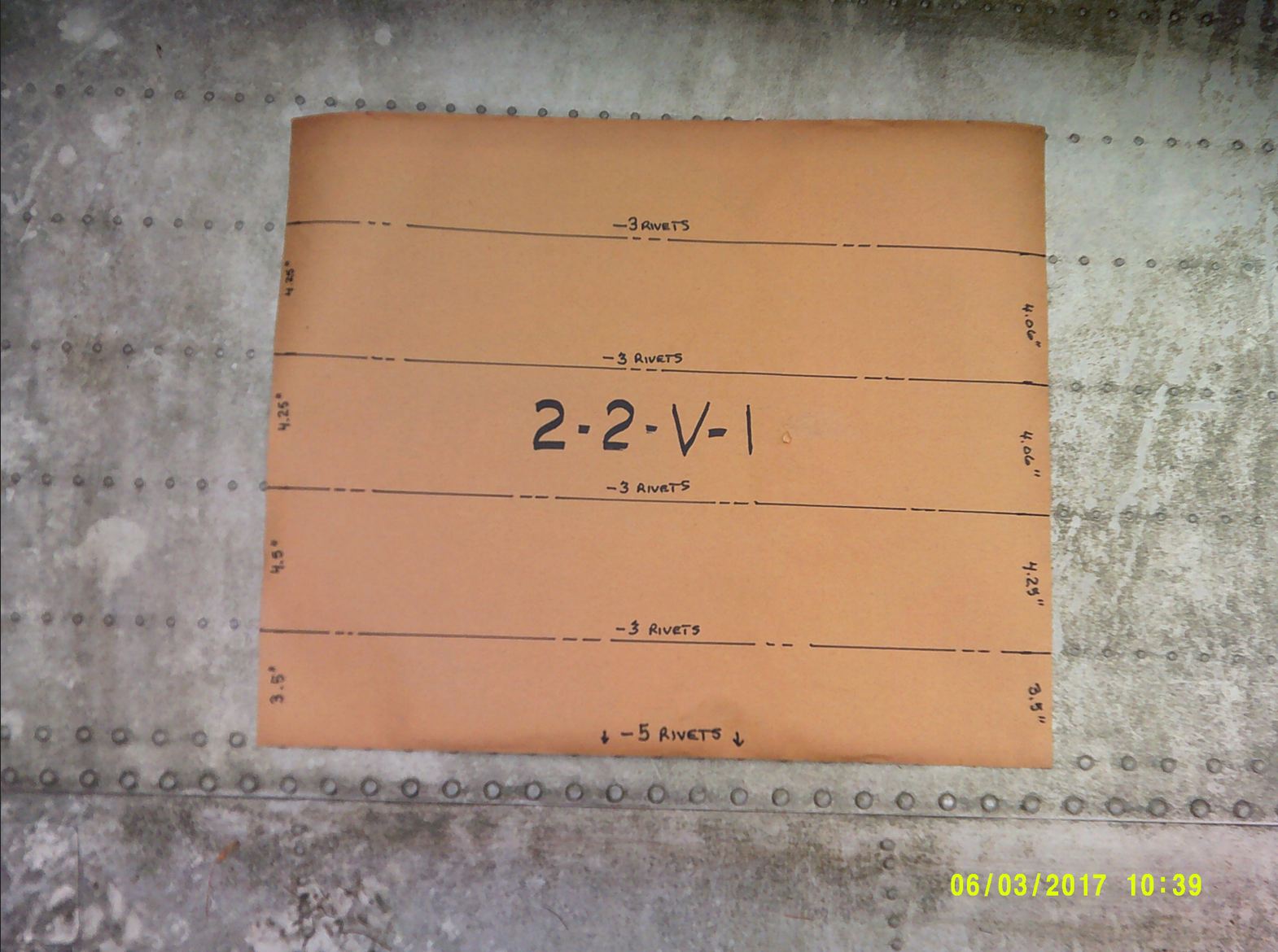 The 2-2-V-1 Template Laid Over the NEAM C-47B Wing. Source: Tom Palshaw
The 2-2-V-1 Template Laid Over the NEAM C-47B Wing. Source: Tom Palshaw
MATCHING CHARACTERISTICS
TIGHAR visited the New England Air Museum on July 16, 2017 with artifact 2-2-v-1 to inspect the wing in storage. The inspection was video taped but TIGHAR has not released that tape to the public. Several questions were raised during the inspection that required further inspection. That additional inspection was conducted on July 18, 2017. The results were emailed to TIGHAR. See Appendix II for information about measurement methods.
Rivet size: The size of the rivets in the area of interest on the C-47B wing was questioned. During the follow-up investigation one rivet was removed from the wing in this area on Tuesday, 7-18-17. This confirmed the rivets in question were -3 brazier head rivets. These match the known rivet size and length of the artifact. (Side note: The rivets on the C-49J wing, constructed 1942, are also -3 rivets.) The thickness of the underlying stringer was measured and found to be 0.060" thick.
Rivet pitch variation of the -5 rivets: Artifact 2-2-V-1 has rivet pitch variations of the -5 rivets. It was initially assumed that C-47B wing rear spar** rivets had a constant pitch of 1.25”. When re-examined on 7-18-17, it was found that the wing rivet pitch varied randomly from 1 3/16 to 1 9/16 inches; see photo below. There was no obvious reason for these variations. This new information should be compared with the data from the Artifact 2-2-V-1.
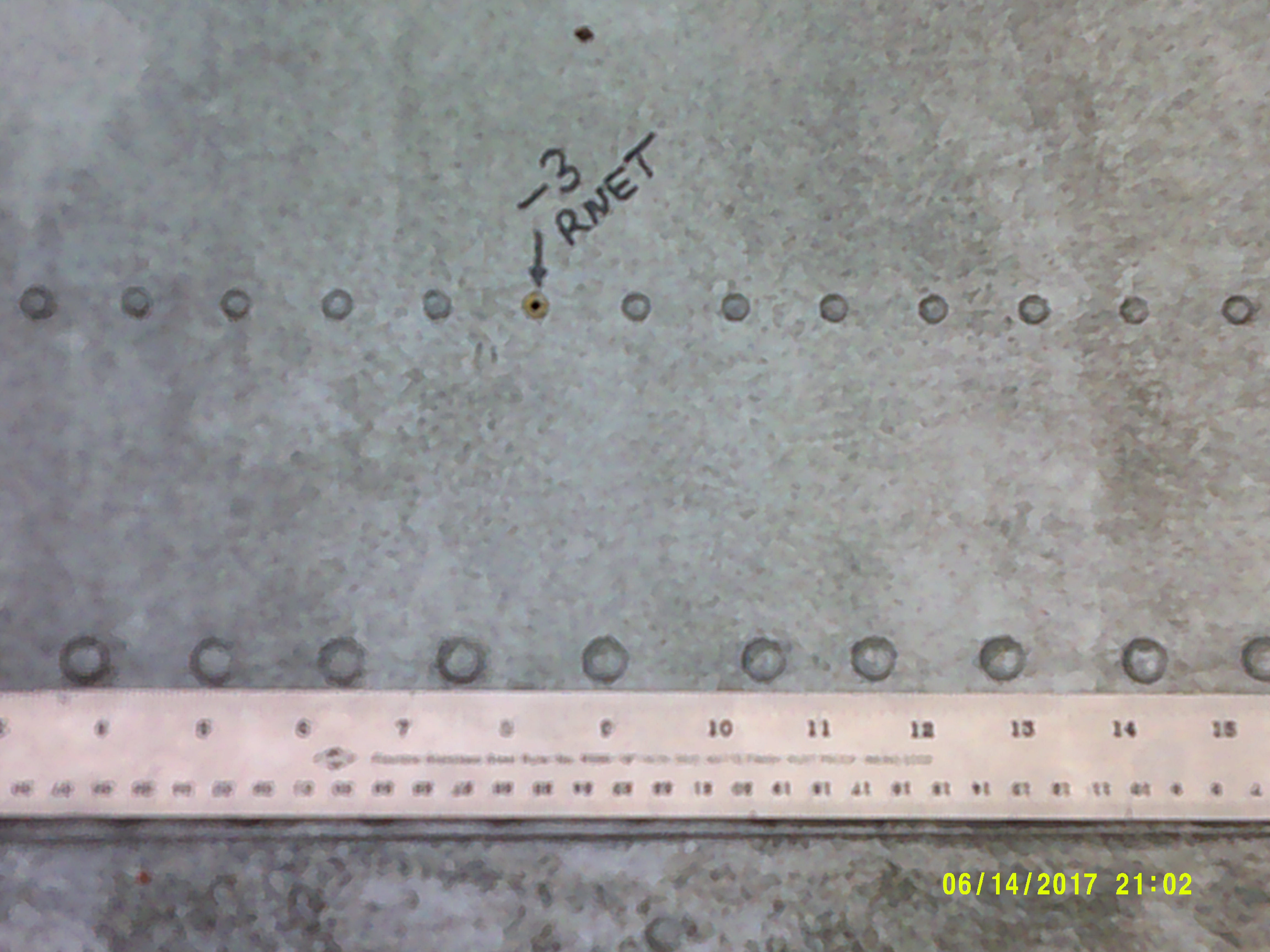 Irregular Spacing of -5 Rivets on C-47B Wing. Source: Tom Palshaw
Irregular Spacing of -5 Rivets on C-47B Wing. Source: Tom Palshaw
WHAT ON ARTIFACT 2-2-V-1 MATCHES THE WING OF A C-47B?
- The artifact and the wing skin are 0.032" thick Alclad aluminum.
- The -3 brazier head rivets have 1" pitch and 0.060" underlying stringers.
- The stringer alignment matches the data published in TIGHAR TRACKS.
- The -5 brazier head rivets match the varying pitch of the tab and the rear spar** of the wing. The spacing between the rows of the -5 rivets matches the rear spar** of the wing.
- The artifact rows of -5 rivets do not match the lower frame of the Lockheed 10 window. The Lockheed 10 rivets were smaller and more closely spaced; see photo below. This indicates that the artifact did not come from Amelia's airplane.
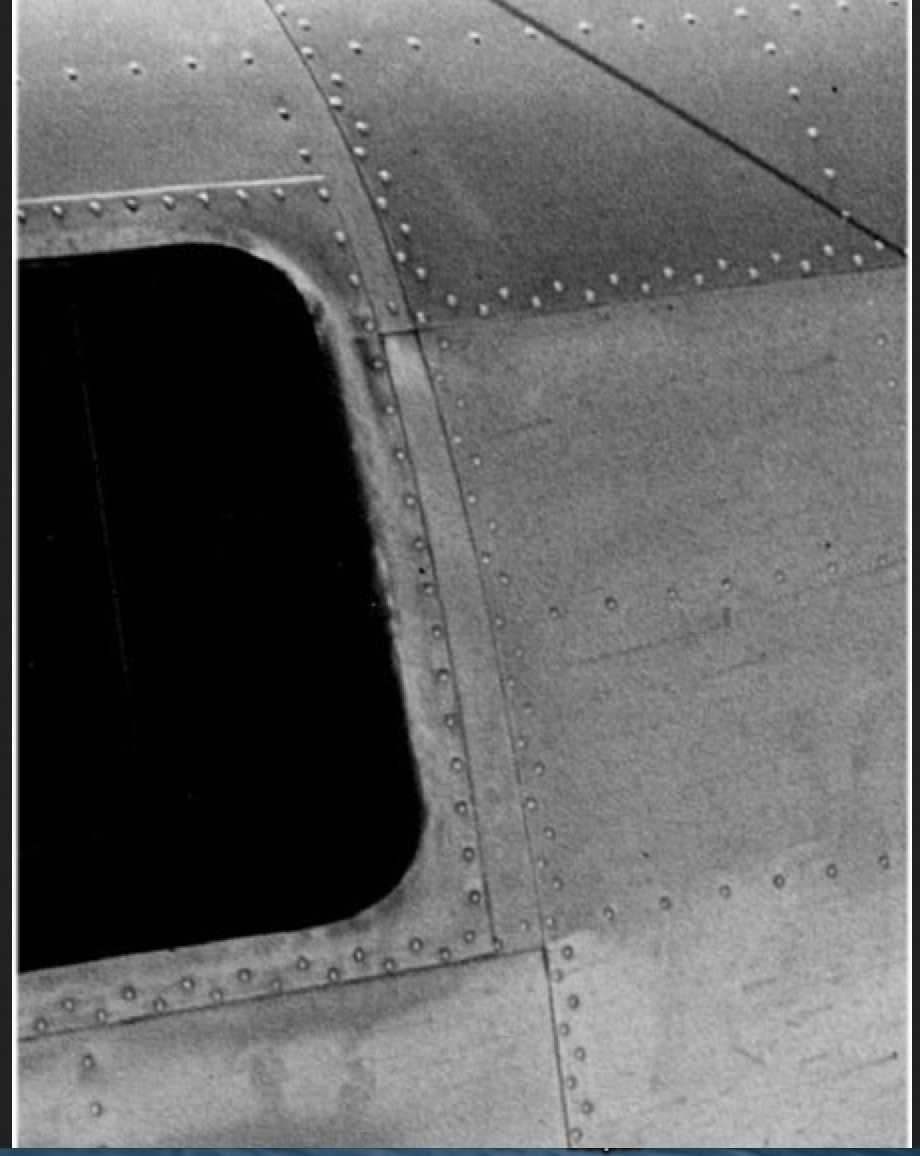 Lockheed 10 Window Frame. Source: TIGHAR
Lockheed 10 Window Frame. Source: TIGHAR
- The s/n of the Sydney Island crash (13890, 1943 ) and the Bradley crash (15013, 1944 ) are reasonably close.
- The only surviving component from the crash on Sydney Island was the right wing, which broke off when it hit a tree, C-47A, s/n 13890, AAF# 43-30739.
- The Gilbertese settlers were known to travel to Sydney Island and salvage material from crashed aircraft.
- The chemical composition of the artifact matches World War Two aluminum, not 1930's aluminum; see table below.
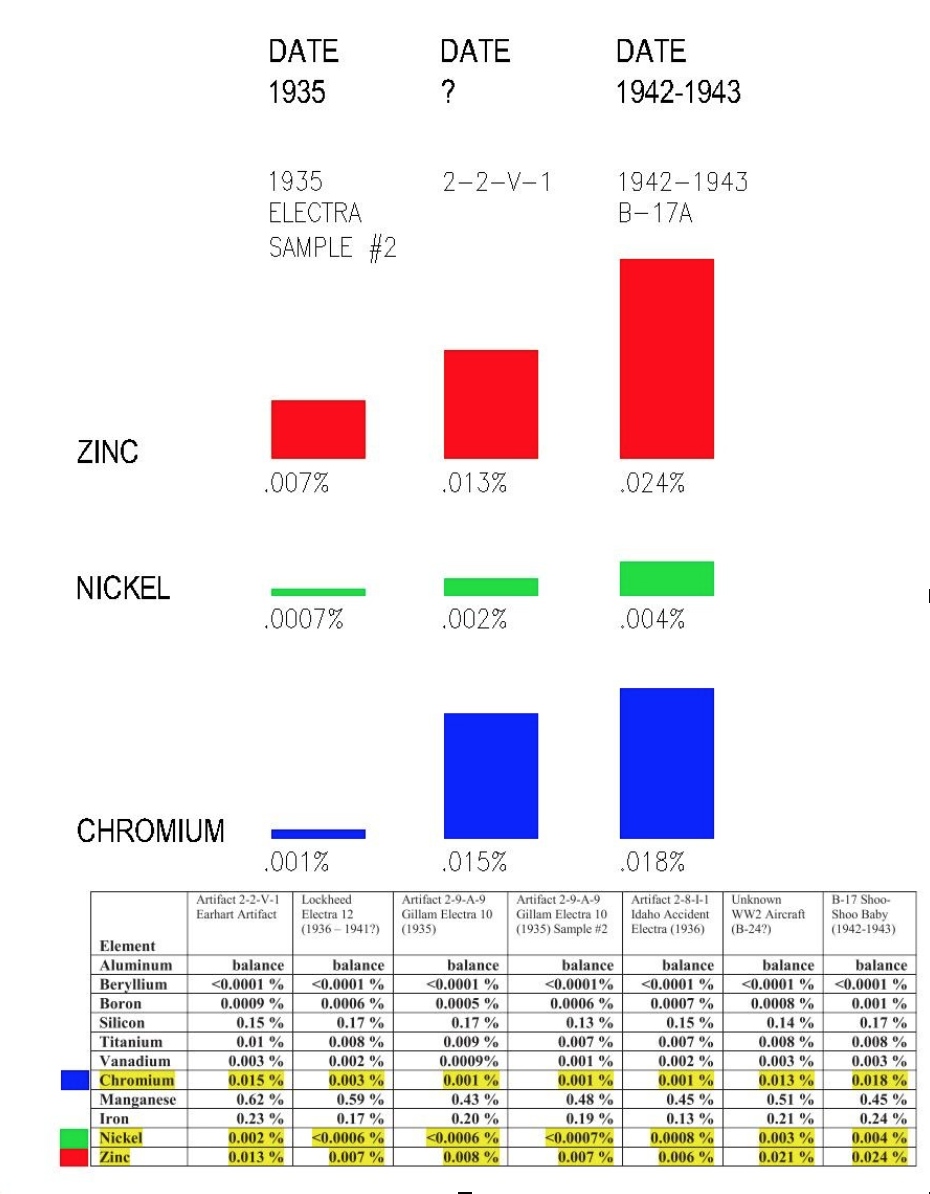
Lehigh Testing Lab Chemical Analysis Data, Job # R-48-20 Dated Jan 6, 2015. Source: TIGHAR
CONSEQUENTIAL CHARACTERISTICS
It was assumed that the fatigue failure on artifact 2-2-V-1 was caused by back and forth bending of the artifact while still attached to the source aircraft. This cannot be proven. The bending could have occurred later. The fatigue failure lines are so straight as to have another possible meaning. If the artifact had been wrenched from an attached underlying structure the fracture line should have been more uneven based upon the variance of stress at and between attaching fasteners. It is quite possible that artifact 2-2-V-1 was originally larger when removed from the source aircraft. A piece could then have been removed later by placing the artifact between two straight angles and flexed to failure by locals to make handicrafts. This would better explain why the fatigue fracture is absolutely straight.
** - Note: As originally published, this report mistakenly referred to the center spar of the NEAM C-47B wing as the location of a line of -5 rivets that corresponds to a line of -5 rivets on 2-2-V-1. The rear spar is the correct location of that rivet line, as the report now states.
-----
UPDATE FEBRUARY 5, 2020: EVALUATING THE THICKNESS of 2-2-V-1 and the C-47 WING SKIN
Note: The views presented here are strictly the views of the author. The New England Air Museum is a 501c3 educational organization and does not hold a position on this research. They have provided their artifacts for research to benefit the public's interest in the topic. I thank them for their cooperation.
HISTORIC RESEARCH
When researching historic events one starts with observed data, forms an opinion, and then researches deeper to validate the data. The data is then submitted for peer review and questioning.
2-2-V-1 AND THE C-47B WING
The investigation of Artifact 2-2-V-1 raised some detailed questions regarding a match to the upper skin on the right wing of a C-47B constructed in 1944.
These questions can be divided into two categories; 1. Deliberate characteristics (original design features) and 2. Consequential characteristics caused by events during the life of the artifact.
Deliberate characteristics include skin thickness, material composition, and structural attachment. They also include rivet type, size, pitch, and location. If any of these characteristics differ between the artifact and the wing then it can be said that the wing is not the source of the artifact.
Consequential characteristics are caused by events experienced by the artifact over time. It cannot be assumed that all features occurred at the same time. Artifact 2-2-V-1 shows clear evidence of a violent crash. It also shows signs of post crash cutting and repetitive fatigue bending fractures. While these features help to define the artifact, they might not eliminate a C-47 wing as its source as described here later.
Earlier discussions involved rivets, patterns, and materials. This update is centered on DC-3/C-47skin thickness, and whether it is a match to artifact 2-2-V-1.
SKIN THICKNESS
Aluminum sheet is identified by its "nominal" thickness. Our discussion is about 028 and 032 ALCLAD (0.028" and 0.032" respectively). This is the number used when ordering, designing, or repairing a structure. It is a deliberate characteristic.
Manufacturing aluminum sheet is made with a production tolerance. This is limited by an industry or government specification. QQ-A-335 dated December 7, 1939, Federal Specification for Aluminum-Alloy (AL-24) is an example. The production tolerance for the thickness and width of our research is + or - 0.0025". This means that 028 can be 0.0255" to 0.0305" and 032 can be 0.0295" to 0.0345".
It is important to use the production tolerance standard appropriate to the artifact. The modern production tolerance for the same thicknesses today is + or - 0.0015".
MEASURING THE THICKNESS OF ALUMINUM SHEET
Measuring the thickness of a new sheet of ALCLAD is as simple as using a standard 1" micrometer. The metal is smooth, flat, and clean. Once the metal has been installed, or exposed to the elements, several factors can affect the accuracy of the measurement. These include a paint coating, corrosion, shape, installed fastener effects and stress induced changes to its original dimensions.
The lack of access to both sides of the sheet would require measuring the step at the edge of the sheet. This can be done with a depth gage or dial indicator. Modern techniques such as eddy current and ultrasonic micrometers can be used when only one side is available. (see appendix for a description of ultrasonic measurement)
THE DC-3 AND C-47B WINGS
The original measurement done at the New England Air Museum was done on the DC-3 wing. The wing was in a cradle so the inboard edge of the wing skin was available. The "nominal" thickness was found to be 0.032". The wing has since been installed so the original measurement cannot be repeated.
The C-47B wing is a spare cut inboard of the center section flange of an accident aircraft. The aft edge step of the skin was first measured with a depth micrometer. This was repeated later using a dial indicator. Both measurements exceeded 0.032". This created a dilemma as both the DC-3 and the C-47 structural repair manuals list this skin to be 028 (nominal).
ULTRASONIC THICKNESS MEASUREMENT RESULTS
The Bombardier Business Aircraft Service Center, located in Windsor Locks CT, provided a level 2 NDT technician to perform ultrasonic thickness measurements on the DC-3 and C-47B wings. The equipment used was a calibrated Olympus 38DL PLUS Ultrasonic Thickness Gage utilizing an M116-RM, 20MHz, transducer, p/n U8400039. Both aircraft right wings were inspected by selecting five locations between the -3 rivet lines in the area of interest.
C-47B, s/n 15013, 43-49197, N74844, Manufactured 1944
Skin condition: Unpainted alclad but weathered from 50+ year's exposure to the elements. The surface was cleaned with a Scotchbrite pad to a smooth finish.
Thickness measurements: 0.032", 0.031", 0.032", 0.031", 0.032"
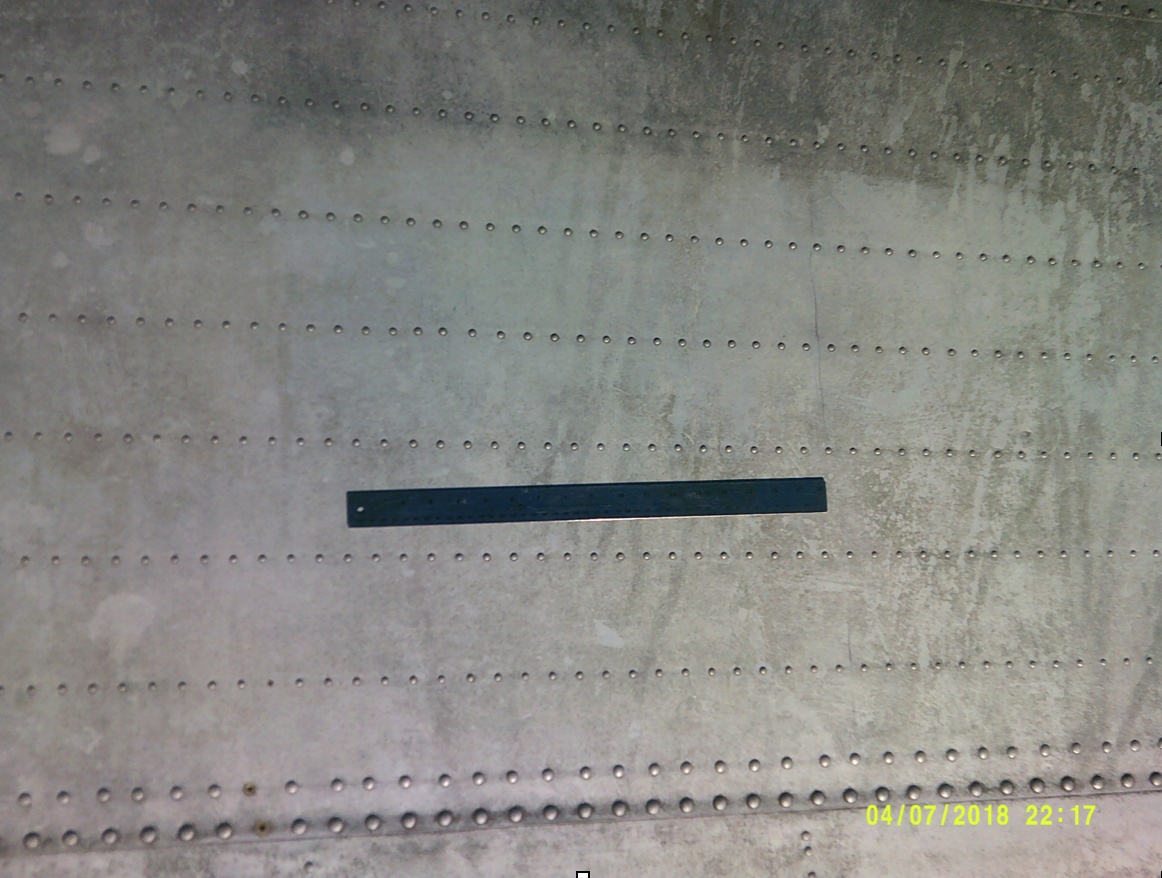
DC-3, s/n 6314, 43-1973, NC-55792, Manufactured 1942
Skin condition: Clean, smooth, polished Alclad.
Thickness measurements: 0.027", 0.030", 0.030", 0.027", 0.028"
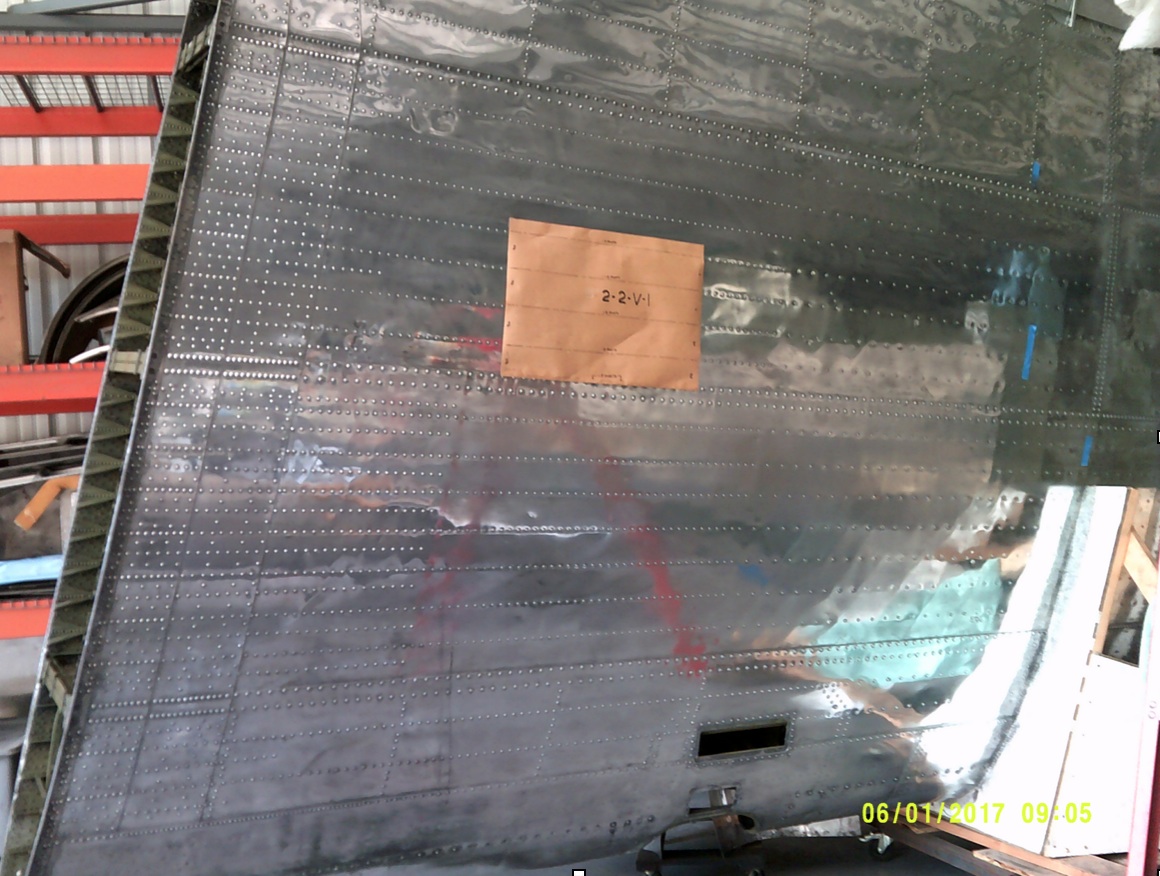
ARTIFACT 2-2-V-1
The artifact has been identified as 032 Alclad by several testing labs. It is assumed that this is the "nominal" thickness, as no actual thickness measurements have been published. Consequential effects listed above would also apply to measurements on 2-2-V-1. The edge marked "Failure #1" would have to pass through the elastic yield limit (41kpsi) before finally failing at its ultimate limit (52kpsi), possibly changing the thickness. The metal would have stretched before it failed. (Elongation minimum in 2 inches = 10%, ref QQ-A-355). The edge marked "Failure #2", the hacked edge, did not experience the same stresses, and would have retained its original thickness. A more detailed investigation of the artifact's thickness variation would be needed to determine if stress had this effect.
CONCLUSIONS
Given the results of both the mechanical and ultrasonic thickness measurements of the C-47 wing indicating a skin thickness of 032 ALCLAD we are left with two questions to answer:
1. Do other C-47 wings have the same result regardless of the structural repair manual data?
2. Does engineering data approval exist that permits the installation of 032 skins? Possibly engineering changes to Douglas Drawing 5115200.
---
October 2020 Update:
Is the Damage to 2-2-v-1 Consistent with the Damage to the C-47 Wing on Sidney Island?
If 2-2-v-1 came from the Sidney Island C-47 crash then two criteria must be met:
Does 2-2-v-1 match the skin pattern of a C-47 wing? Previous research indicates that it does.
Is the damage to 2-2-v-1 consistent with the damage to the C-47 wing on Sidney Island? The following analysis proposes that it could.
1. A photo of the Sidney Island wing from a 1943 Army Air Force accident report shows that the tree impacted the right wing just outboard of the engine nacelle near wing station 35.8. Loose panels of skin can be seen hanging from the fracture zone (note: wing is lying upside down in this photo). This is consistent with the area of interest on the NEAM wing, as indicated in the analysis image #1 beneath the photo.


2. See analysis image #2 below; all fracture numbers were provided by TIGHAR. Fracture #2 could have been caused when the tree cut through the wing. Fracture #1 could have been caused when the tree impacted the spar, pushing it aft. The -5 and -6 rivet lines failed when the spar, being stronger than the skin, moved aft.
3. See analysis image #2 below; failure #3 was in part caused by the crash and in part caused by fatigue bending when the panel was salvaged by local people. The hacked edge was also caused when the panel was salvaged from a larger piece.
4. Image #3 below shows the -3, -5, and -6 rivet lines of a C-47 wing.
A. The -3 rivets match artifact 2-2-v-1.
B. The -5 rivets match the varied pitch of the -5 rivets in 2-2-v-1.
C. The -6 rivets are consistent with the larger partial hole in 2-2-v-1.
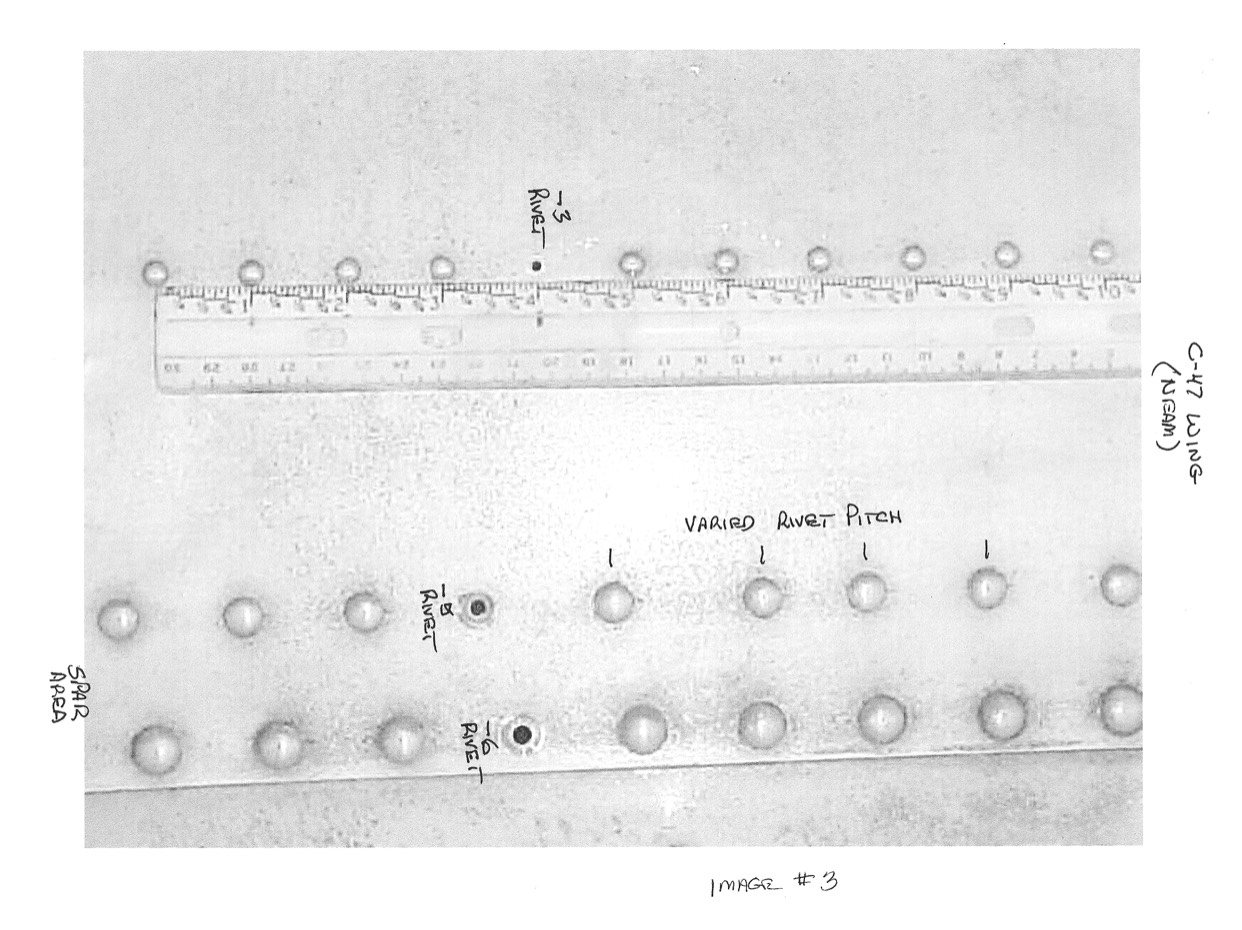
Conclusion
While this analysis does not prove that 2-2-v-1 came from the Sidney Island crash, it does show that it is possible. The Sidney Island crash cannot be ruled out.
CONTACT
Questions and comments can be sent to the author at:
![]()
REFERENCES
Original Report
TIGHAR TRACKS, April 30, 1992, vol 8 #3, page 5.
NTSB Report # 92-40, Mar 5,1992, DCA 37-I-A001, July 5, 1937
‘The Crash at Sydney Island’ TIGHAR Project Report #7, 7/26/98
Lehigh Testing Lab, Job # R-48-20 Dated Jan 6, 2015
Air Safety Network accident reports (Flight Safety Foundation)
February 5 Update
1. NTSB Report 92-40, Mar 5, 1992
2. MMR Report 128927, Aug 27, 2019
3. ASTM B209-96
4. TIGHAR Tracks, vol35 #3, Oct 2019
5. Federal Standard QQ-A-355, Dec 7, 1939
6. Olympic Industrial Resources, Tom Nelligan (extract)
October 2020 Update
The Sydney C-47 wing photo is from an Army Air Force Accident report dated 17 December 1943, accident number 44-12-17-507.
See the Ghost of Gardner Island blog for additional information not covered above.
---
APPENDIX I: C-47 ACCIDENT REPORT
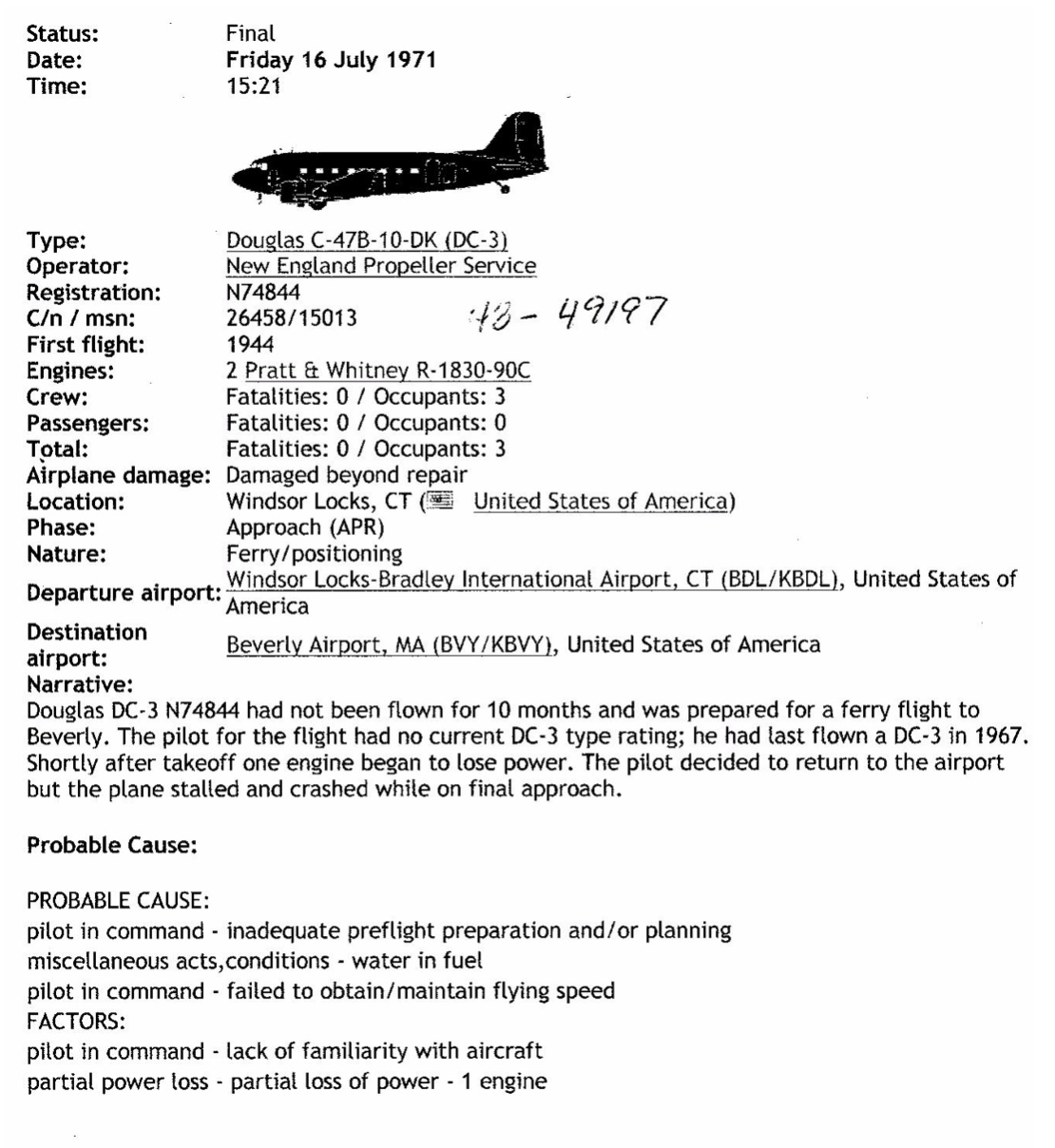
APPENDIX II: MEASUREMENT METHODS
Let me start by making a blanket statement: All rivets are identified by the size of the shank, not by the size of the head.
To identify installed rivets in any structure would require determining both the shank diameter and the grip length. Rivet diameter is in 1/32", grip length is in 1/16". A -4 rivet is 4/32" in diameter. Reference FAA Mechanics General Handbook AC-65-9(1970), Chapter 6, page 127, figure 6-31 shown below.
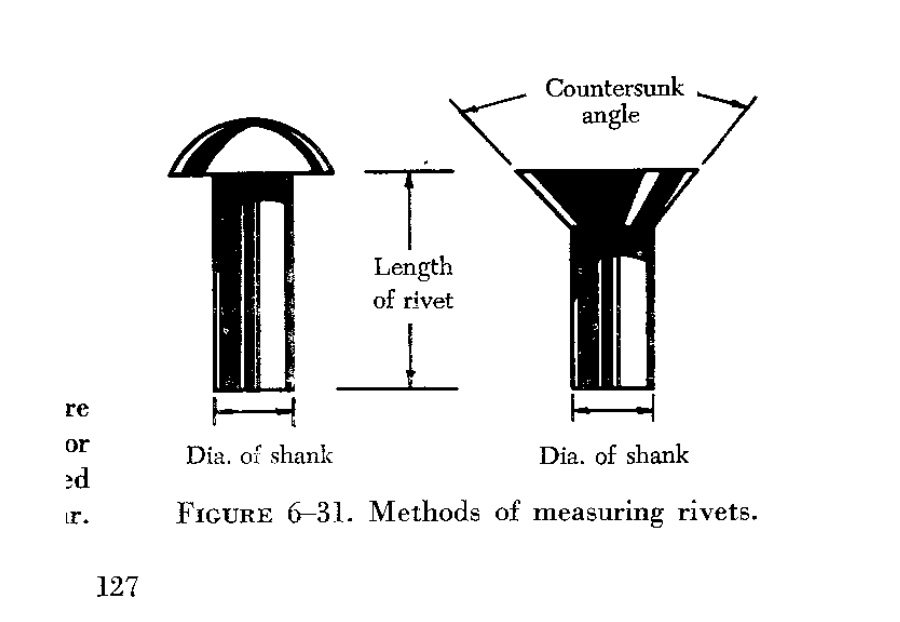
The rivet may have to be removed to accurately determine its true characteristics. This should be done to a standard practice such as FAA Airframe Manual AC65-15, Chapter 5, page 167 to ensure that the rivet hole is not enlarged or damaged.
Brazier head rivets are obsolete so technical data is harder to find. The Aircraft Mechanics Handbook published by Chas. A. Bennett Inc. in 1944 contains a chart for Brazier head rivets. See chart below from Section 2, page 5, figure 6 of that manual.
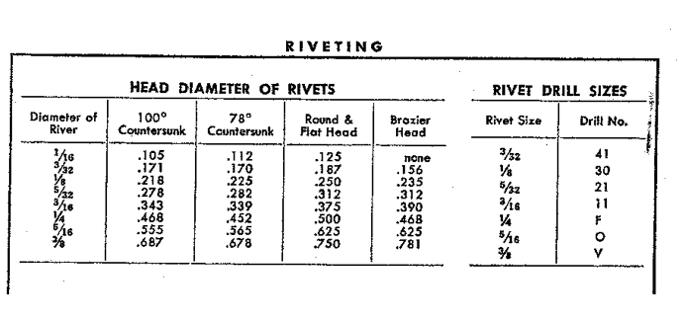
This chart shows the standard head dimensions of a brazier head rivet. Brazier head rivets were available under two standards, AN455 and AN456. When the supply of these rivets were checked at the New England Air Museum collection it was found that brazier head rivets can have two head sizes of the same dash number. See the photo belowof these samples.

It would be nearly impossible to accurately determine the rivet size by just looking at the head. The rivet must be removed from the structure. This is the process that was performed on the C-47B wing; see photo below.
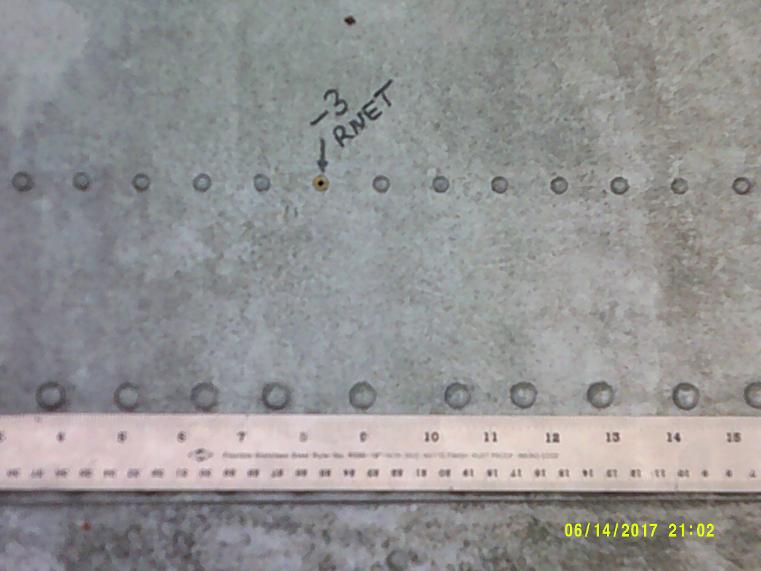
Once the rivet is removed, check the hole size by inserting the appropriate drill. Reference Canadair Challenger Structural Repair Manual (1981), 51-42-11, page 6, figure 4, shown below.
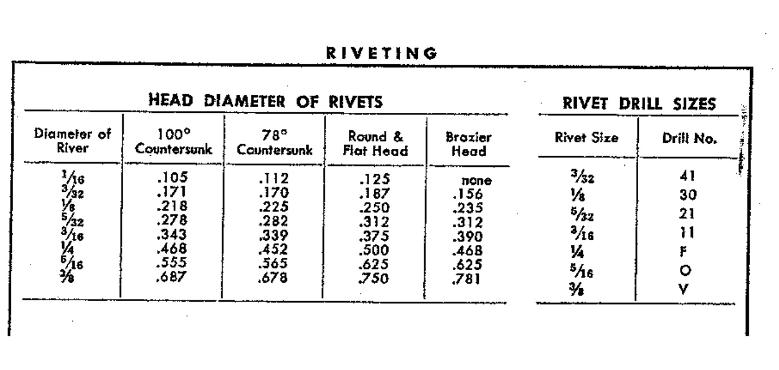
The same procedure was performed for the -5 rivets. Note also the variations in the rivet pitch of the -5 rivets.
To determine the grip length it was necessary to first measure the skin thickness. This was done by using a micrometer at the edge of the skin. To measure the grip length a "calibrated" cleco was used to compare a known stack up of aluminum to that of the wing. The result was a skin thickness of 0.032" and a stringer thickness of 0.060". This is similar to the NTSB Report.
One final note; When the wing of the DC-3 (C-49J) built in 1942 was compared to the same area on the C-47B wing built in 1944, the structure was completely different. It is important that when researching this issue, the c/n of the aircraft should be close.
Appendix III: OLYMPUS INDUSTRIAL RESOURCES by Tom Nelligan (Extracted from a larger article)
Ultrasonic thickness gauging is a widely used nondestructive test technique for measuring the thickness of a material from one side. It is fast, reliable, and versatile, and unlike a micrometer or caliper it requires access to only one side of the test piece. The first commercial ultrasonic guages, using principles derived from sonar, were introduced in the late 1940s. Small, portable instruments optimized for a wide variety of test applications became common in the 1970s. Later advances in microprocessor technology led to new levels of performance in today's sophisticated, easy-to-use miniature instruments.
How ultrasonic thickness gauges work: Sound energy can be generated over a broad frequency spectrum. Audible sound occurs in a relatively low frequency range with an upper limit around twenty thousand cycles per second (20 Kilohertz). The higher the frequency, the higher the pitch we perceive. Ultrasound is sound energy at higher frequencies, beyond the limit of human hearing. Most ultrasonic testing is performed in the frequency range between 500 KHz and 20 MHz, although some specialized instruments go down to 50 KHz or lower and as high as 100 MHz. Whatever the frequency, sound energy consists of a pattern of organized mechanical vibrations traveling through a medium such as air or steel according to the basic laws of wave physics.
Ultrasonic thickness gauges work by very precisely measuring how long it takes for a sound pulse that has been generated by a small probe called an ultrasonic transducer to travel through a test piece and reflect back from the inside surface or far wall. Because sound waves reflect from boundaries between dissimilar materials, this measurement is normally made from one side in a "pulse/echo" mode.
The transducer contains a piezoelectric element which is excited by a short electrical impulse to generate a burst of ultrasonic waves. The sound waves are coupled into the test material and travels through it until they encounter a back wall or other boundary. The reflections then travel back to the transducer, which converts the sound energy back into electrical energy. In essence, the gage listens for the echo from the opposite side. Typically this time interval is only a few millionths of a second. The gage is programmed with the speed of sound in the test material, from which it can then calculate thickness using the simple mathematical relationship:
T = (V) x (t/2)
where T = the thickness of the part
V = the velocity of sound in the test material
t = the measured round-trip transit time
It is important to note that the velocity of sound in the test material is an essential part of this calculation. Different materials transmit sound waves at different velocities, generally faster in hard materials and slower in soft materials, and sound velocity can change significantly with temperature. Thus it is always necessary to calibrate an ultrasonic thickness gage to the speed of sound in the material being measured, and accuracy can be only as good as this calibration.
Sound waves in the megahertz range do not travel efficiently through air, so a drop of coupling liquid is used between the transducer and the test piece in order to achieve good sound transmission. Common couplants are glycerin, propylene glycol, water, oil, and gel. Only a small amount is needed, just enough to fill the extremely thin air gap that would otherwise exist between the transducer and the target.
Accuracy: Many factors affect measurement accuracy in a given application, including proper instrument calibration, uniformity of material sound velocity, sound attenuation and scattering, surface roughness, curvature, poor sound coupling, and backwall non-parallelism. All of these factors should be considered when selected a gage and transducer. With proper calibration, measurements can usually be made to an accuracy of +/- 0.001" or 0.01 mm, and in some cases accuracy can approach 0.0001" or 0.001 mm. Accuracy in a given application can best be determined through the use of reference standards of precisely known thickness. In general, gages using delay line or immersion transducers for Mode 3 measurements are able to determine the thickness of a part most precisely.